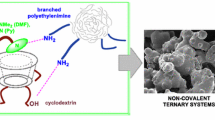Abstract
According to the chemical design, electrorheological properties of supramolecular complex from β-cyclodextrin polymer (β -CDP) were discussed. Six supramolecular complexes of β-cyclodextrin polymer with substituted salicylic acid and 3-hydroxy-2-naphthoic acid were synthesized by the solid-phase self-assembly method, and their component and structure were characterized by NMR, FT-IR, UV-vis and the fluorescence analysis. Then the electrorheological properties of their suspensions in silicone oil were investigated under DC electric fields. It was found that the yield stresses of these supramolecular complex ER fluids were 7.3–9.8 kPa at 4 kV/mm in DC electric field, which were enhanced by 34%–72% compared with that of pure β-CDP. Among them, that of β-CDP/3-hydroxy-2-naphthoic acid ER fluid was the highest. It was also found that the ER effect of supramolecular complexes can be controlled by changing different guests. When the substituted group is at phenyl ring, ER behavior can be slightly adjusted by the different substituted groups, their number as well as their position at phenyl ring. This can be proved by the measurement of dielectric properties.
Similar content being viewed by others
References
Haleey, T., Electrorheological fluids, Science, 1992, 258: 761- 766.
Vieira, S. L., Nakano, M., Transient behavior of the microstructure of in shear flow mode, Proceedings of the 7th International Conferenxe on ER Fluids and Magneto-rheological Suspensions (ed. Tao, R.), Singapore: World Scientific, 2000, 152–160.
Kim, S. G., Kim, J. W., Jang, W. H. et al., Electrorheological characteristics of phosphate cellulose-based suspensions, Polymer, 2001, 42:5005–5012.
Fan, J. J., Zhao, X. P., Huang, M. et al., Adjustable character of microwave attenuation in BaTiO3 electrorheological fluids, Progress in Natural Science, 2002, 12(10): 1070–1074.
Qiu, Z. Y., Shan, F. K., Zhou, L. W. et al., High AC voltage flow-modified permittivity and rheological properties of carbon-doped nano TiO2 ER fluids, Proceedings of the 7th International Conferenxe on ER Fluids and Magneto-rheological Suspensions (ed. Tao, R.), Singapore: World Scientific, 2000, 72–79.
Hao, T., Electrorheological fluids, Advanced in Colloid and Interface Science, 2002, 97: 1–35.
Zhao, X. P., Duan, X., In situ sol-gel preparation of polysaccha-ride/titanium oxide hybrid colloids and their electrorheological effect, J. Colloid Interface Sci., 2002, 251: 376–380.
Zhao, X. P., Yin, J. B., Preparation and electrorheological fluids characteristic of rare-earth-doped TiO2 suspensions, Chem. Mater., 2002, 14: 2258–2263.
Wang, B. X., Zhao, X. P., Electrorheological effect coordinated by kaolinite-carboxymethyl starch hybrid materials, J. Mater. Chem., 2002, 12: 2869–2871.
Lu, J., Zhao, X. P., Electrorheological properties of suspensions based on polyaniline-montmorillonite-clay nanocomposite, J. Mater. Res., 2002, 17: 1513–1519.
Whitesides, G. M., Mthias, J. P., Seto, C. T., Molecular self-assembly and nanochemistry: a chemical strategy for the synthesis of nanostructures, Science, 1991, 254: 1312–1319.
Liu, Y., Kang, S. C., Molecular recognition on supramolecular systems (XXXV)—Synthesis of novel β-cyclodextrin derivative bearing pyridinio group and its chiral discrimination of amino acids, Science in China, Ser. B, 2001, 44(3): 260–267.
Liu, Y., Yang, Y. W., Cao, R. et al., Thermodynamic origin of molecular selective binding of bile salts by aminated β-cyclodextrins, J. Phys. Chem. B, 2003: 14130–14139.
Liu, Y., Chen, G. S., Li, L. et al., Inclusion complexation and solubilization of paclitaxel by bridged bis(β-cyclodextrin)s containing a tetraethylenepentaamino spacer, J. Med. Chem., 2003, 46(22): 4634–4637.
Yoshida, K., Shimomura, T., Ito, K. et al., Inclusion complex formation of cyclodextrin and polyaniline, Langmuir, 1999, 15(4): 910–913.
Crini, G., Bertini, S., Torri, G. et al., Sorption of aromatic compounds in water using insoluble cyclodextrin polymers, J. Appllied Polymer Science, 1998, 68: 1973–1978.
Renard, E., Deratani, A., Volet, G. et al., Preparation and characterization of water soluble high molecular weight β-cyclodextrin-epichlorohydrin polymers, Eur. Polym. J., 1997, 33(1): 49–57.
Gao, Z. W., Zhao, X. P., Electrorheological properties of inclusive complex of β-cyclodextrin polymer, Materials Letters, 2002, 57: 615–618.
Gao, Z. W., Zhao, X. P., Enhancing electrorheological behaviors with formation of β-cyclodextrin supramolecular complex, Polymer, 2003, 44: 4519–4526.
Su, X. D., Liu, L. Z., Shen, H. Y., Study on the absorbing enrichment of trace metals using α-pyridylaxo-β-naphthol inclusion complexes of cyclodextrin polymer resin, Analytical Chemistry (in Chinese), 1995, 23(12): 1361–1366.
Catena, G. C., Bright, F. V., Thermodynamic study on the effects of β-cyclodextrin inclusion with anilinonaphthalenesulfonates, Anal. Chem., 1989, 61: 905–909.
Kano, K., Tatsumi, M., Hashimoto, S., Cyclodextrin-induced conformational enantiomerism of dinaphthylmethanes, J. Org. Chem., 1991, 56: 6579–6585.
Author information
Authors and Affiliations
Corresponding author
Rights and permissions
About this article
Cite this article
Gao, Z., Zhao, X., Sun, P. et al. Supramolecular complex formation of β-cyclodextrin polymer with substituted salicylic acid or 3-hydroxy-2-naphthoic acid and their electrorheological behaviors. Sc. China Ser. B-Chem. 47, 340–348 (2004). https://doi.org/10.1360/03yb0249
Received:
Issue Date:
DOI: https://doi.org/10.1360/03yb0249




